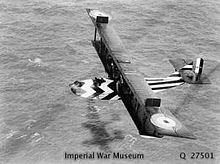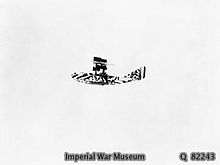- Felixstowe F.2
-
F2A 
Felixstowe F.2A N4297 in flight. Role Military flying boat Manufacturer S.E.Saunders Ltd
Aircraft Manufacturing Co Ltd
May, Harden & MayDesigner John Cyril Porte First flight February 1917 Introduction 1917 Primary users Royal Naval Air Service
Royal Air Force
United States NavyNumber built 175 Variants Felixstowe F.3
Felixstowe F.5
Felixstowe F5LThe Felixstowe F.2 was a 1917 British flying boat class designed and developed by Lieutenant Commander John Cyril Porte of the Royal Navy at the Seaplane Experimental Station, Felixstowe during the First World War adapting a larger version of his superior Felixstowe F.1 hull design married with the larger Curtiss H12 flying boat. The Felixstowe hull had superior water contacting attributes and became a key base technology in most seaplane designs thereafter.
Contents
Design and development
Before the war Porte had worked with American aircraft designer Glenn Curtiss on a flying boat, the "America" in which they intended to cross the Atlantic in order to win the £10,000 prize offered by the British Daily Mail newspaper for the first aircraft to cross the Atlantic. Following the outbreak of war in Europe, Porte returned to England and rejoined the Royal Navy, becoming commander of the naval air base at Felixstowe where he recommended the purchase from Curtiss of an improved version of the "America" flying boat on which he had worked, the Curtiss H-4 type,[1] resulting the RNAS receiving two prototype Americas and 62 H-4s.[2]
The Curtiss H-4s were found to have a number of problems, being underpowered with its hull too weak for sustained operations and having poor handling characteristics when afloat or taking off.[3][4] One flying boat pilot, T.D Hallam, wrote that they were "comic machines, weighing well under two tons; with two comic engines giving, when they functioned, 180 horsepower; and comic control, being nose heavy with engines on and tail heavy in a glide."[5]
To try to resolve the H-4's hydrodynamic issues, in 1915 Porte carried out a series of experiments on four H-4s fitted with a variety of modified hulls,[3] using the results of these tests to design a new 36-foot-long (11 m) hull which was fitted to the wings and tail of a H.4, serial number 3580, with a pair of 150 hp (112 kW) Hispano-Suiza 8 engines as the Felixstowe F.1.[6] Rather than the lightweight boat-type structure of the Curtiss boats, the F.1's hull was based around a sturdy wooden box-girder similar to that used in contemporary landplanes, to which were attached a single-step planing bottom and side sponsons. Once modified by the fitting of a further two steps, the new hull proved to give much better take and landing characteristics and was much more seaworthy.[7][8]
Porte then designed a similar hull for the larger Curtiss H12 flying boat, which while larger and more capable than the H-4s, shared failings of a weak hull and poor water handling. The combination of the new Porte-designed hull, this time fitted with two steps, with the wings of the H-12 and a new tail, and powered by two Rolls-Royce Eagle engines was named the Felixstowe F.2 and first flew in July 1916,[9] proving greatly superior to the Curtiss on which it was based.[10] It entered production as the Felixstowe F.2A, being used as a patrol aircraft, with about 100 being completed by the end of World War I. Another seventy were built, and these were followed by two F.2c which were built at Felixstowe.
In February 1917, the first prototype of the Felixstowe F.3 was flown. This was larger and heavier than the F.2, giving it greater range and heavier bomb load, but poorer agility. Approximately 100 Felixstowe F.3s were produced before the end of the war.
The Felixstowe F.5 was intended to combine the good qualities of the F.2 and F.3, with the prototype first flying in May 1918. The prototype showed superior qualities to its predecessors but the production version was modified to make extensive use of components from the F.3, in order to ease production, giving lower performance than either the F.2A or F.5.
Operational history
The Felixstowe F.2A was widely used as a patrol aircraft over the North Sea until the end of the war. Its excellent performance and maneuverability made it an effective and popular type, often fighting enemy patrol and fighter aircraft, as well as hunting U-boats and Zeppelins. The larger F.3, which was less popular with its crews than the more maneuverable F.2a, served in the Mediterranean as well as the North Sea.
The F.5 did not enter service until after the end of World War I, but replaced the earlier Felixstowe boats (together with Curtiss flying boats) to serve as the RAF's standard flying boat until being replaced by the Supermarine Southampton in 1925.
Variants
- F.2a: Based on Curtiss H12 with new hull. Powered by two 345 hp Rolls-Royce Eagle VIII engines. 4 to 7 machine guns and 460 lb of bombs.
- F.2c: Modified F2a with lighter hull. two built.
Operators
Specifications (F2a)
Data from British Naval Aircraft since 1912 [11]
General characteristics
- Crew: 4
- Length: 46 ft 3 in (14.1 m)
- Wingspan: 95 ft 7½ in (29.15 m)
- Height: 17 ft 6 in (5.34 m)
- Wing area: 1,133 ft² (105.3 m²)
- Empty weight: 7,549 lb (3,431 kg)
- Loaded weight: 10,978 lb (4,990 kg)
- Powerplant: 2 × Rolls-Royce Eagle VIII V12 piston, 345 hp (257 kW) each
Performance
- Maximum speed: 95½ mph at 2,000 ft (83 knots, 154 km/h)
- Service ceiling: 9,600 ft (2,930 m)
- Wing loading: 9.69 lb/ft² (47.4 kg/m²)
- Power/mass: 0.063 hp/lb (0.10 kW/kg)
- Endurance: 6 hours
- Climb to 2,000 ft (610 m): 3 min 50 s.
- Climb to 10,000 ft (3,050 m): 39 min 30 s.
Armament
- Guns: 4 × .303 in (7.7 mm) Lewis Guns, 1 in nose, 3 amidships
- Bombs: Up to 460 lbs of bombs beneath wings
See also
- Related development
References
- Notes
- Bibliography
- Bruce, J.M. "The Felixstowe Flying-Boats: Historic Military Aircraft No. 11, Part 1." Flight, 2 December 1955, pp. 842–846.
- Bruce, J.M. "The Felixstowe Flying-Boats: Historic Military Aircraft No. 11, Part 2." Flight, 16 December 1955, pp. 895–898.
- Bruce, J.M. "The Felixstowe Flying-Boats: Historic Military Aircraft No. 11, Part 3." Flight, 23 December 1955, pp. 929–932.
- Bruce, J.M. British Aeroplanes 1914-18. London: Putnam, 1957.
- Hallam, T.D. The Spider Web: The Romance of a Flying Boat War Flight. London: William Blackwood, 1919.
- London, Peter. British Flying Boats. Stroud, UK: Sutton Publishing, 2003. ISBN 0-7509-2695-3.
- Thetford, Owen. British Naval Aircraft since 1912. London: Putnam, Fourth edition 1978. ISBN 0-370-30021-1.
External links
Aircraft designed by Seaplane Experimental Station, Felixstowe Felixstowe F.1 • Felixstowe Porte Baby • Felixstowe F.2 • Felixstowe F.3 • Felixstowe F.5 • Felixstowe F5L • Felixstowe Fury •
People and aircraft Campaigns and battles Strategic bombing (German, Cuxhaven) · Bombing of cities · Fokker Scourge · Flight over Vienna · Bloody April · BattlesEntente Powers air services Australian Flying Corps · British air services (Royal Flying Corps, Royal Naval Air Service, Royal Air Force) · French Air Service · Imperial Russian Air Force · Italian Military Air Corps · United States Army Air Service · Greek air services (Army Air Service, Naval Air Service)Central Powers air services German air services (Army Air Service, Navy Air Service) · Austro-Hungarian Imperial and Royal Aviation Troops · Ottoman Air Force · Bulgarian Army Aeroplane SectionLists relating to aviation General Aircraft (manufacturers) · Aircraft engines (manufacturers) · Airlines (defunct) · Airports · Civil authorities · Museums · Registration prefixes · Rotorcraft (manufacturers) · TimelineMilitary Accidents/incidents Records Categories:- British patrol aircraft 1910–1919
- Seaplanes and flying boats
- Felixstowe aircraft
Wikimedia Foundation. 2010.


